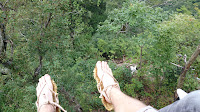I kept with the adventurous spirit and once again found
myself in mountain town of Misasa the following weekend of September 5th. This
time I was here thanks to an invite from the Misasa International Exchange, who
every year puts on a weekend long event at the famously dangerous Mt.
Mitoku.
Mt. Mitoku is a notable hike not only due to its treacherous
nature, but also its spiritual one. The hike is a pilgrimage in both the Shinto
and Buddhist faiths, where the climb purifies your senses and your mind. Part
of that process is wearing a sash as you climb up, which you will see in the
photos.
 |
| Yep that's the 'trail' |

This hike was one of the most enjoyable ones I have ever taken. It was truly challenging, with incredibly steep gradients, sections where tree routes are used as ladder rungs, rocky ridges traversed with drops on either side, and boulders you ascend using a chain. I opted to make the journey in the monk's rice straw sandals, called waraji. This was the best decision I could have made. The grip was inexplicably solid, and the freedom to move my toes around gave me great maneuverability throughout the rocky incline.
On the way up we passed two shrines with fantastic vistas of
the valley below, as well as a massive bell, which when rung grants the ringer
an extra 5 years of life. Considering one of the International Exchange members
has made this summit 50 times and moved more gracefully than many of the other
JETs, I believe it.

 Near the end of the hike we wandered through a dark passage behind
a shrine nestled into a alcove, where we then rounded the corner to see a
massive cliff face with another shrine wedged into the middle of it.
Near the end of the hike we wandered through a dark passage behind
a shrine nestled into a alcove, where we then rounded the corner to see a
massive cliff face with another shrine wedged into the middle of it.This shrine, Nageiredo, according to legend, was constructed at the base of Mt. Mitoku and thrown into its current place by the monk upon completion. The name literally means thrown (nage) put into (ire) shrine (do). Honestly, I find that story easier to believe than it being built in its current location. The shrine hosts the Kongo Zao Gongen, a Shinto & Buddhist deity revered for quelling earthquakes stomping the ground to frighten earthquake-causing spirits. So yes, much everything about Mt. Mitoku is over-the-top.
After the equally fun descent down the mountain, we stopped at the museum at the base, which houses the statues of the temples on the mountain. We also stopped at this small statue. When you pour water on it, a tranquil series of bells underground begins to ring all around you. Thankfully my phone was able to capture the sound.
Afterwards we all
headed to Misasa's onsen. This marked round 2 on my Misasa onsen punch card,
just one more visit and I will be cured of all diseases (see previous blog).
 Afterwards we returned to Mt. Mitoku's base temple, which
also doubles as a ryokan where we were invited to eat a traditional, vegetarian,
monk meal. We learned the logic behind the vegetarian meals, called shoujin
ryouri, as well as the phrases "itadakimasu" and "gochisousama
deshita" which are said at the beginning and end of every meal. Monks eat
a vegetarian diet out of respect for life, so when they eat they try to consume
as little life as possible, and by the same logic they consider plant life to
have less life than animal life. The habitual before and after meal phrases actually
stem from long Buddhist prayers that used to be said before and after meals,
and over time were shorted just to the most important words.
Afterwards we returned to Mt. Mitoku's base temple, which
also doubles as a ryokan where we were invited to eat a traditional, vegetarian,
monk meal. We learned the logic behind the vegetarian meals, called shoujin
ryouri, as well as the phrases "itadakimasu" and "gochisousama
deshita" which are said at the beginning and end of every meal. Monks eat
a vegetarian diet out of respect for life, so when they eat they try to consume
as little life as possible, and by the same logic they consider plant life to
have less life than animal life. The habitual before and after meal phrases actually
stem from long Buddhist prayers that used to be said before and after meals,
and over time were shorted just to the most important words.
Shortly afterward the International Exchange club broke out
games and drinks and desserts, and we all spent the evening having fun and
staying up late.
The next morning we all arose bright and early at 6am to
participate in the monk's Zanzen meditation. The unique trait of Zanzen mediation
is it involves being hit on the back with a paddle to help keep blood
circulating to your legs throughout the meditation. Oddly enough it does work
quite well, and increases endurance in that static position by quite a bit.
This was one fantastic trip! So much so that I plan on
making the pilgrimage again sometime soon.
 PPS. Apparently sometime later our journey made the
newspaper. Not sure why exactly, but this tends to happen when lots of foreigners
get together to do something in rural areas.
PPS. Apparently sometime later our journey made the
newspaper. Not sure why exactly, but this tends to happen when lots of foreigners
get together to do something in rural areas.































